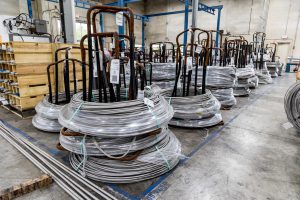MIG. TIG. JIG. PIG.
The first two words are more than members of a BIG rhyme scheme (Okay, we’ll stop!) They’re techniques that create durable welds.
But what are the differences between MIG welding and TIG welding? A welder must know the differences in these techniques to determine which is right for them.
What is MIG Welding?
MIG stands for Metal Inert Gas. This technique strikes an arc between a continuously fed electrode and a metal piece. The arc melts these elements to form a welding pool protected by a shielding gas. The wire is usually connected to a power source.
This technique is also known as GMAW (Gas Metal Arc Welding).

MIG Welding Applications
GMAW welding is often used in large-scale projects. This is because this technique creates sturdy welds that stand strong in rain or shine. Common MIG welding projects are:
- Structural steel
- Railroads
- Car parts
What is TIG Welding?
TIG means Tungsten Inert Gas. The name comes from the non-consumable tungsten electrode used in the process. The power-connected electrode forms an arc with the workpiece. This method is easy for welders to control since the electrode isn’t consumed during the process. An inert gas protects the arc weld during the welding process.
The term GTAW (Gas Tungsten Arc Welding) is another common name for this technique.
When to Use TIG Welding
TIG welds form the bones of infrastructure. Popular uses for GTAW welds include:
- Pipe
- Sheet metal
- Machine parts

What You Need to Consider
Which of these methods should you use?
Both methods create durable welds. But their strengths are shown in separate places. Here’s what you should know before making your decision.
Which is Best for Beginners?
TIG welding requires dexterity. Welders m
GMAW welding is often used in the largest use of one hand to hold the welding torch and the other to feed the filling rod. Their feet are as busy as their hands, pressing at a foot pedal to control the weld.
The machine used in the MIG process frees the hands by feeding the wire to the welder. MIG welders also avoid the challenge of the foot pedal. This makes the MIG process easier for beginner welders to learn.
Which Weld is Stronger?
Want a long-lasting weld?
Both processes create durable welds when done well. But welders that want an unbreakable weld rely on the TIG technique. This is partly because this technique needs an expert welder behind it. Its precision creates a strong arc that’s capable of cutting through metal.

Which Materials Can I Use?
TIG is better for thinner materials such as low-alloy steels, aluminum, and copper. Thicker metals, including stainless steel, are better suited for MIG welding.
Which Technique is Speedier?
The MIG welding process is faster. The weld rod feeding and lack of movement in TIG welding results in a slower process. This is why mass production relies on MIG welders to quickly create lots of product.
Which Technique Creates a Better Appearance?
TIG welding indeed costs more. But that cost results in beautiful, detailed welds. TIG welding’s heat control makes it easier to avoid mistakes. The result often requires little more than some polish to make it beautiful.
Learn to Weld at ETI
No welding technique is superior. They have different strengths and applications.
That’s why you need to master them all. At ETI welding school, you can become an expert in TIG, MIG, and more.
Visit our website for more information about our welding training program.
Learn more about Welding Careers:
 (888) 830-7678
(888) 830-7678


